International Human Resource Management Report: Wangz Hotel, Japan
VerifiedAdded on 2022/10/11
|13
|2666
|15
Report
AI Summary
This report provides a comprehensive analysis of international human resource management (IHRM) strategies for Wangz Hotel, a Singapore-based company, as it plans to expand its operations into Japan. The report begins with an executive summary and an introduction that highlights the significance of IHRM in a globalized business environment. It then delves into the specific context of Japan, examining its cultural dimensions through Hofstede's model to understand how Japanese culture impacts business operations. The report outlines the proposed organizational design and structure for Wangz Hotel in Japan, followed by a detailed discussion of staffing procedures, including estimating human capital requirements, recruitment, selection, and placement. The report also covers training and development programs tailored to the hospitality industry and the remuneration strategy, considering currency valuation differences and financial reporting implications. The analysis includes the importance of cultural adaptation, staffing challenges, and the need for appropriate training and development programs. The report concludes with a summary of key findings and recommendations for Wangz Hotel's successful entry into the Japanese market.
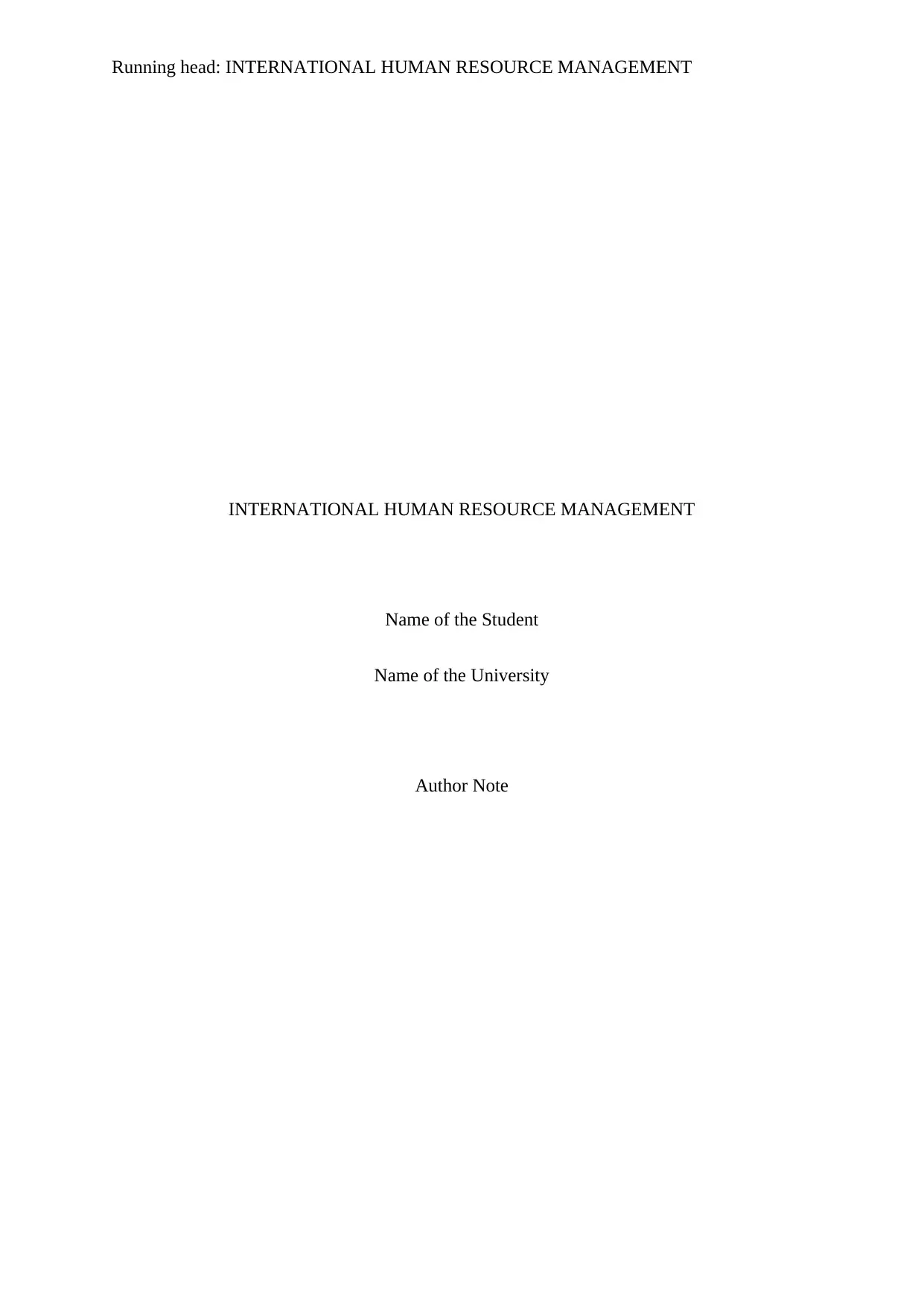
Running head: INTERNATIONAL HUMAN RESOURCE MANAGEMENT
INTERNATIONAL HUMAN RESOURCE MANAGEMENT
Name of the Student
Name of the University
Author Note
INTERNATIONAL HUMAN RESOURCE MANAGEMENT
Name of the Student
Name of the University
Author Note
Paraphrase This Document
Need a fresh take? Get an instant paraphrase of this document with our AI Paraphraser

1INTERNATIONAL HUMAN RESOURCE MANAGEMENT
Executive Summary
The report focuses on discussing the significance of international human resource
management with respect to the company Wangz. The differentiation of the countries
Singapore and Japan are explained through Hofstede model. A basic introduction of the
company and the guest country are done along with cultural dimension analysis. The
organisational structure for the proposed deal had been depicted along with understanding the
different stages involved in staffing and training-development. The remuneration strategy as
per currency valuation differences and company financial reporting are also discussed.
Executive Summary
The report focuses on discussing the significance of international human resource
management with respect to the company Wangz. The differentiation of the countries
Singapore and Japan are explained through Hofstede model. A basic introduction of the
company and the guest country are done along with cultural dimension analysis. The
organisational structure for the proposed deal had been depicted along with understanding the
different stages involved in staffing and training-development. The remuneration strategy as
per currency valuation differences and company financial reporting are also discussed.

2INTERNATIONAL HUMAN RESOURCE MANAGEMENT
Table of Contents
Introduction................................................................................................................................3
Japan: Significance of International HRM.................................................................................3
Background of the study........................................................................................................3
Proposed Organisational design and structure...........................................................................4
Staffing procedure......................................................................................................................7
Training and development..........................................................................................................9
Remuneration.............................................................................................................................9
Conclusion................................................................................................................................10
Reference..................................................................................................................................11
Table of Contents
Introduction................................................................................................................................3
Japan: Significance of International HRM.................................................................................3
Background of the study........................................................................................................3
Proposed Organisational design and structure...........................................................................4
Staffing procedure......................................................................................................................7
Training and development..........................................................................................................9
Remuneration.............................................................................................................................9
Conclusion................................................................................................................................10
Reference..................................................................................................................................11
⊘ This is a preview!⊘
Do you want full access?
Subscribe today to unlock all pages.

Trusted by 1+ million students worldwide
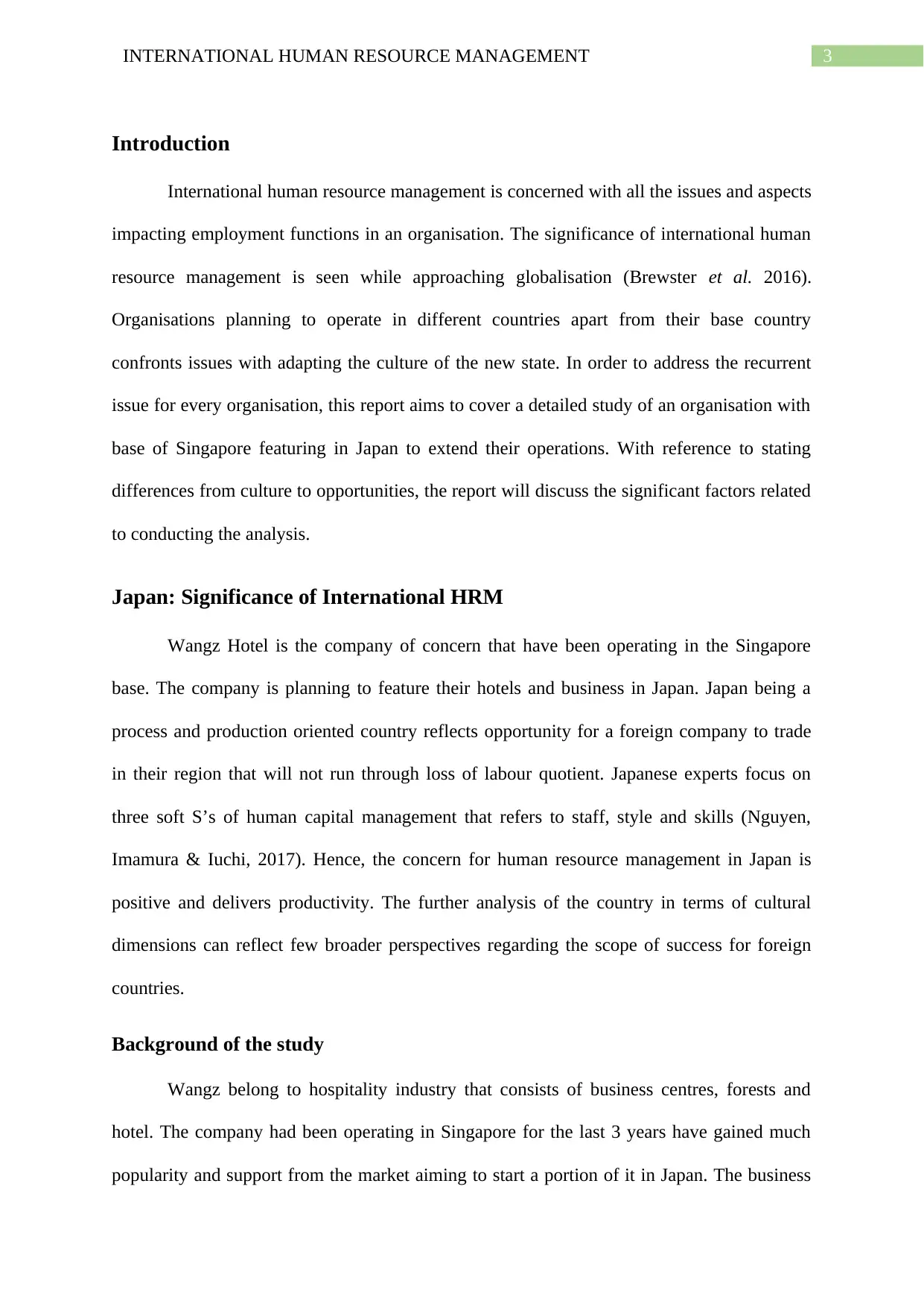
3INTERNATIONAL HUMAN RESOURCE MANAGEMENT
Introduction
International human resource management is concerned with all the issues and aspects
impacting employment functions in an organisation. The significance of international human
resource management is seen while approaching globalisation (Brewster et al. 2016).
Organisations planning to operate in different countries apart from their base country
confronts issues with adapting the culture of the new state. In order to address the recurrent
issue for every organisation, this report aims to cover a detailed study of an organisation with
base of Singapore featuring in Japan to extend their operations. With reference to stating
differences from culture to opportunities, the report will discuss the significant factors related
to conducting the analysis.
Japan: Significance of International HRM
Wangz Hotel is the company of concern that have been operating in the Singapore
base. The company is planning to feature their hotels and business in Japan. Japan being a
process and production oriented country reflects opportunity for a foreign company to trade
in their region that will not run through loss of labour quotient. Japanese experts focus on
three soft S’s of human capital management that refers to staff, style and skills (Nguyen,
Imamura & Iuchi, 2017). Hence, the concern for human resource management in Japan is
positive and delivers productivity. The further analysis of the country in terms of cultural
dimensions can reflect few broader perspectives regarding the scope of success for foreign
countries.
Background of the study
Wangz belong to hospitality industry that consists of business centres, forests and
hotel. The company had been operating in Singapore for the last 3 years have gained much
popularity and support from the market aiming to start a portion of it in Japan. The business
Introduction
International human resource management is concerned with all the issues and aspects
impacting employment functions in an organisation. The significance of international human
resource management is seen while approaching globalisation (Brewster et al. 2016).
Organisations planning to operate in different countries apart from their base country
confronts issues with adapting the culture of the new state. In order to address the recurrent
issue for every organisation, this report aims to cover a detailed study of an organisation with
base of Singapore featuring in Japan to extend their operations. With reference to stating
differences from culture to opportunities, the report will discuss the significant factors related
to conducting the analysis.
Japan: Significance of International HRM
Wangz Hotel is the company of concern that have been operating in the Singapore
base. The company is planning to feature their hotels and business in Japan. Japan being a
process and production oriented country reflects opportunity for a foreign company to trade
in their region that will not run through loss of labour quotient. Japanese experts focus on
three soft S’s of human capital management that refers to staff, style and skills (Nguyen,
Imamura & Iuchi, 2017). Hence, the concern for human resource management in Japan is
positive and delivers productivity. The further analysis of the country in terms of cultural
dimensions can reflect few broader perspectives regarding the scope of success for foreign
countries.
Background of the study
Wangz belong to hospitality industry that consists of business centres, forests and
hotel. The company had been operating in Singapore for the last 3 years have gained much
popularity and support from the market aiming to start a portion of it in Japan. The business
Paraphrase This Document
Need a fresh take? Get an instant paraphrase of this document with our AI Paraphraser
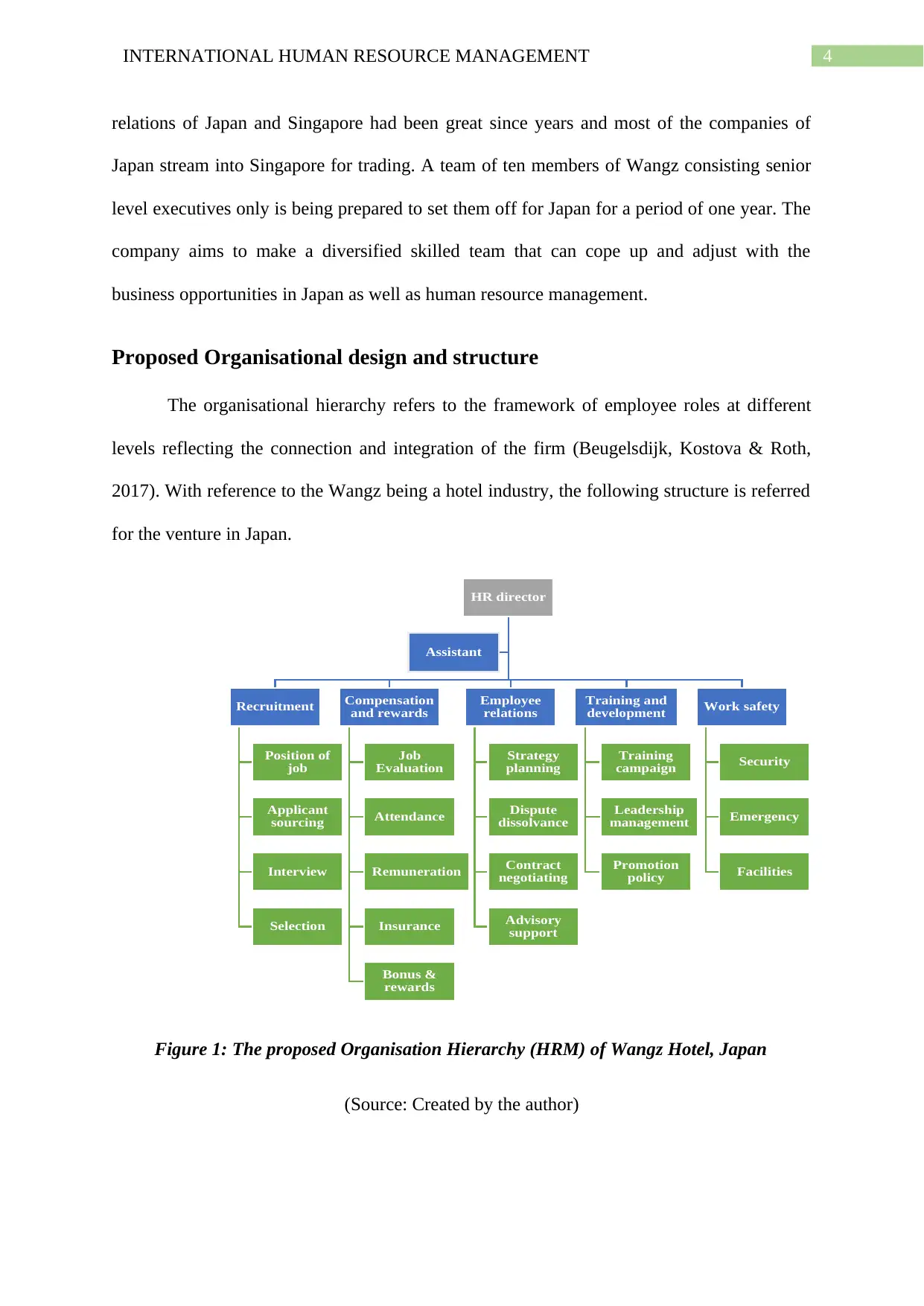
4INTERNATIONAL HUMAN RESOURCE MANAGEMENT
relations of Japan and Singapore had been great since years and most of the companies of
Japan stream into Singapore for trading. A team of ten members of Wangz consisting senior
level executives only is being prepared to set them off for Japan for a period of one year. The
company aims to make a diversified skilled team that can cope up and adjust with the
business opportunities in Japan as well as human resource management.
Proposed Organisational design and structure
The organisational hierarchy refers to the framework of employee roles at different
levels reflecting the connection and integration of the firm (Beugelsdijk, Kostova & Roth,
2017). With reference to the Wangz being a hotel industry, the following structure is referred
for the venture in Japan.
Figure 1: The proposed Organisation Hierarchy (HRM) of Wangz Hotel, Japan
(Source: Created by the author)
HR director
Recruitment
Position of
job
Applicant
sourcing
Interview
Selection
Compensation
and rewards
Job
Evaluation
Attendance
Remuneration
Insurance
Bonus &
rewards
Employee
relations
Strategy
planning
Dispute
dissolvance
Contract
negotiating
Advisory
support
Training and
development
Training
campaign
Leadership
management
Promotion
policy
Work safety
Security
Emergency
Facilities
Assistant
relations of Japan and Singapore had been great since years and most of the companies of
Japan stream into Singapore for trading. A team of ten members of Wangz consisting senior
level executives only is being prepared to set them off for Japan for a period of one year. The
company aims to make a diversified skilled team that can cope up and adjust with the
business opportunities in Japan as well as human resource management.
Proposed Organisational design and structure
The organisational hierarchy refers to the framework of employee roles at different
levels reflecting the connection and integration of the firm (Beugelsdijk, Kostova & Roth,
2017). With reference to the Wangz being a hotel industry, the following structure is referred
for the venture in Japan.
Figure 1: The proposed Organisation Hierarchy (HRM) of Wangz Hotel, Japan
(Source: Created by the author)
HR director
Recruitment
Position of
job
Applicant
sourcing
Interview
Selection
Compensation
and rewards
Job
Evaluation
Attendance
Remuneration
Insurance
Bonus &
rewards
Employee
relations
Strategy
planning
Dispute
dissolvance
Contract
negotiating
Advisory
support
Training and
development
Training
campaign
Leadership
management
Promotion
policy
Work safety
Security
Emergency
Facilities
Assistant
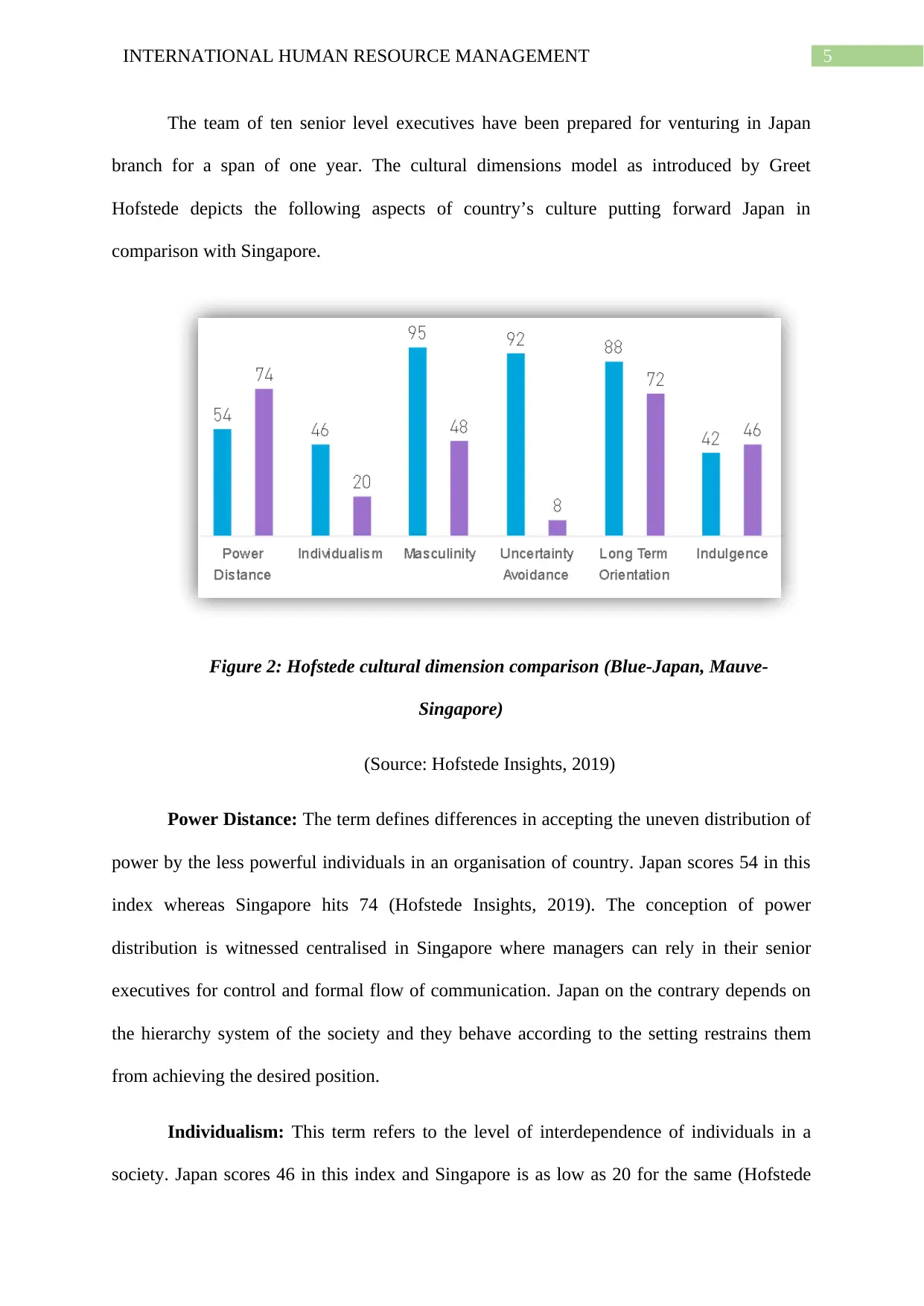
5INTERNATIONAL HUMAN RESOURCE MANAGEMENT
The team of ten senior level executives have been prepared for venturing in Japan
branch for a span of one year. The cultural dimensions model as introduced by Greet
Hofstede depicts the following aspects of country’s culture putting forward Japan in
comparison with Singapore.
Figure 2: Hofstede cultural dimension comparison (Blue-Japan, Mauve-
Singapore)
(Source: Hofstede Insights, 2019)
Power Distance: The term defines differences in accepting the uneven distribution of
power by the less powerful individuals in an organisation of country. Japan scores 54 in this
index whereas Singapore hits 74 (Hofstede Insights, 2019). The conception of power
distribution is witnessed centralised in Singapore where managers can rely in their senior
executives for control and formal flow of communication. Japan on the contrary depends on
the hierarchy system of the society and they behave according to the setting restrains them
from achieving the desired position.
Individualism: This term refers to the level of interdependence of individuals in a
society. Japan scores 46 in this index and Singapore is as low as 20 for the same (Hofstede
The team of ten senior level executives have been prepared for venturing in Japan
branch for a span of one year. The cultural dimensions model as introduced by Greet
Hofstede depicts the following aspects of country’s culture putting forward Japan in
comparison with Singapore.
Figure 2: Hofstede cultural dimension comparison (Blue-Japan, Mauve-
Singapore)
(Source: Hofstede Insights, 2019)
Power Distance: The term defines differences in accepting the uneven distribution of
power by the less powerful individuals in an organisation of country. Japan scores 54 in this
index whereas Singapore hits 74 (Hofstede Insights, 2019). The conception of power
distribution is witnessed centralised in Singapore where managers can rely in their senior
executives for control and formal flow of communication. Japan on the contrary depends on
the hierarchy system of the society and they behave according to the setting restrains them
from achieving the desired position.
Individualism: This term refers to the level of interdependence of individuals in a
society. Japan scores 46 in this index and Singapore is as low as 20 for the same (Hofstede
⊘ This is a preview!⊘
Do you want full access?
Subscribe today to unlock all pages.

Trusted by 1+ million students worldwide

6INTERNATIONAL HUMAN RESOURCE MANAGEMENT
Insights, 2019). Japan reflects a sense of collectivism in their culture that indicates harmony
of collective associations more than individual opinion as well as have strong belief in
defamation. Singapore is considered to be society of collectivism. The “we” factor is
important for them considering belongingness to their family and loyalty. Hence, both the
countries are much dependent on the collective approach of the society scoring less on
individualism index. However, performing in Japan will be much reliable.
Masculinity: The term refers to the differential index of group thoughts on either
being best of liking what is being done. Masculinity refers being the best whereas femininity
is passion for pursuing profession of an individual. Japan scores 95 in this index referring
their motive of trying to achieve the best position in the society (Hofstede Insights, 2019).
The country has a high drive for perfection and excellence in services like restaurants and
hotels pointing an opportunity for Wangz for operating successfully. Singapore, on the
contrary scores 48 in this index referring a feminine side of the society. People in Singapore
like doing the job they do and not always target to be best at that.
Uncertainty avoidance: The term refers to quotient by which a society feels
threatened by unwanted situations or emergencies and consists of a set of stipulated believes.
Japan scores 92 in this index showing maximum power of uncertainties faced. The natural
environment of japan is the most uncertain factor that makes them prepared for any further
issues. From volcanoes to typhoons, tsunamis to earthquakes, Japan goes through all of these.
Singapore scores 8 in this index referring low dimension (Hofstede Insights, 2019). The
country forcefully had to abide by many rules due to penalisation and not in need of the
structure generally.
Long-term orientation: The term indicates the relationship of the past and present
factors of a society in confronting challenges. Japan scores 88 whereas Singapore 72 in this
Insights, 2019). Japan reflects a sense of collectivism in their culture that indicates harmony
of collective associations more than individual opinion as well as have strong belief in
defamation. Singapore is considered to be society of collectivism. The “we” factor is
important for them considering belongingness to their family and loyalty. Hence, both the
countries are much dependent on the collective approach of the society scoring less on
individualism index. However, performing in Japan will be much reliable.
Masculinity: The term refers to the differential index of group thoughts on either
being best of liking what is being done. Masculinity refers being the best whereas femininity
is passion for pursuing profession of an individual. Japan scores 95 in this index referring
their motive of trying to achieve the best position in the society (Hofstede Insights, 2019).
The country has a high drive for perfection and excellence in services like restaurants and
hotels pointing an opportunity for Wangz for operating successfully. Singapore, on the
contrary scores 48 in this index referring a feminine side of the society. People in Singapore
like doing the job they do and not always target to be best at that.
Uncertainty avoidance: The term refers to quotient by which a society feels
threatened by unwanted situations or emergencies and consists of a set of stipulated believes.
Japan scores 92 in this index showing maximum power of uncertainties faced. The natural
environment of japan is the most uncertain factor that makes them prepared for any further
issues. From volcanoes to typhoons, tsunamis to earthquakes, Japan goes through all of these.
Singapore scores 8 in this index referring low dimension (Hofstede Insights, 2019). The
country forcefully had to abide by many rules due to penalisation and not in need of the
structure generally.
Long-term orientation: The term indicates the relationship of the past and present
factors of a society in confronting challenges. Japan scores 88 whereas Singapore 72 in this
Paraphrase This Document
Need a fresh take? Get an instant paraphrase of this document with our AI Paraphraser
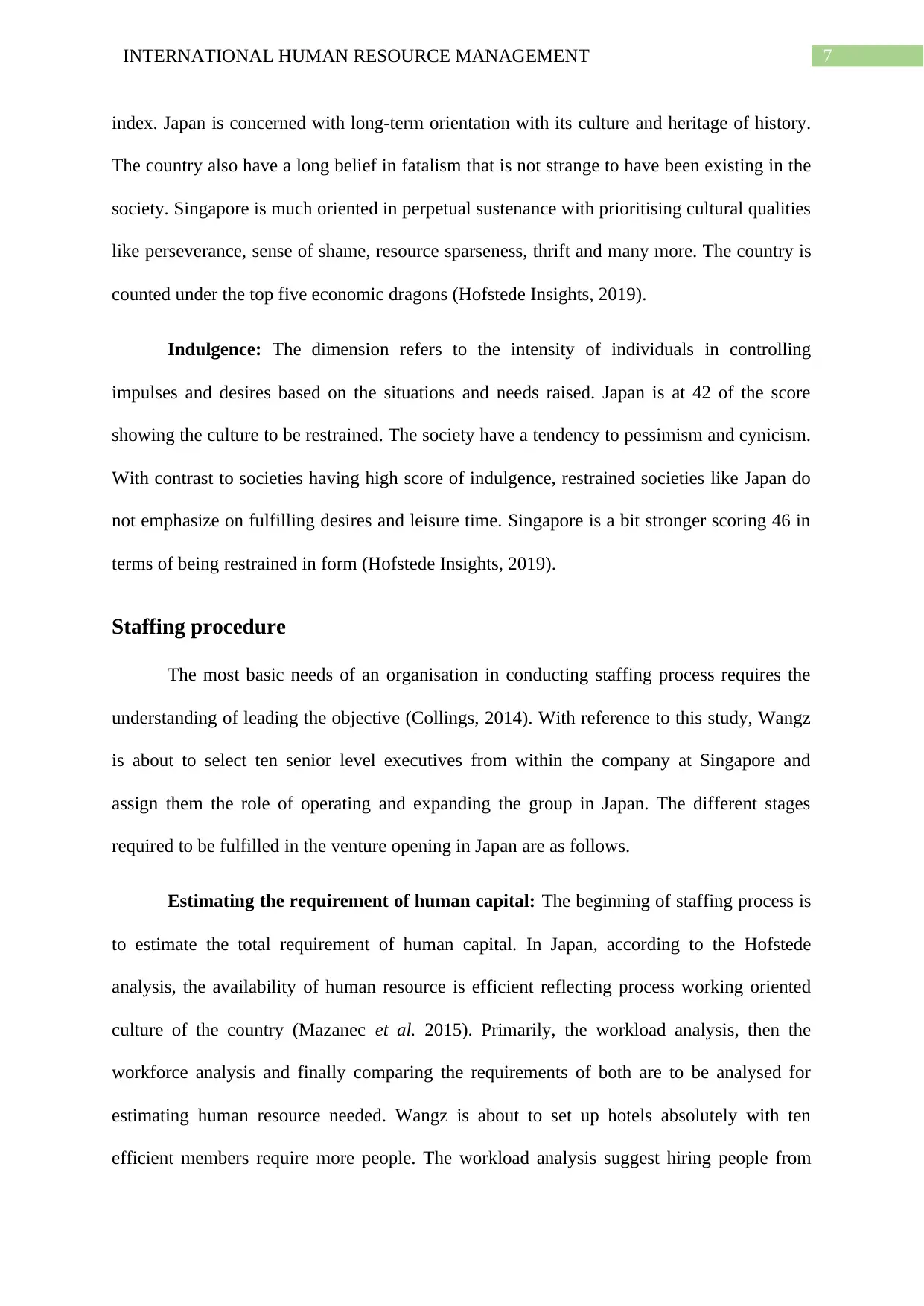
7INTERNATIONAL HUMAN RESOURCE MANAGEMENT
index. Japan is concerned with long-term orientation with its culture and heritage of history.
The country also have a long belief in fatalism that is not strange to have been existing in the
society. Singapore is much oriented in perpetual sustenance with prioritising cultural qualities
like perseverance, sense of shame, resource sparseness, thrift and many more. The country is
counted under the top five economic dragons (Hofstede Insights, 2019).
Indulgence: The dimension refers to the intensity of individuals in controlling
impulses and desires based on the situations and needs raised. Japan is at 42 of the score
showing the culture to be restrained. The society have a tendency to pessimism and cynicism.
With contrast to societies having high score of indulgence, restrained societies like Japan do
not emphasize on fulfilling desires and leisure time. Singapore is a bit stronger scoring 46 in
terms of being restrained in form (Hofstede Insights, 2019).
Staffing procedure
The most basic needs of an organisation in conducting staffing process requires the
understanding of leading the objective (Collings, 2014). With reference to this study, Wangz
is about to select ten senior level executives from within the company at Singapore and
assign them the role of operating and expanding the group in Japan. The different stages
required to be fulfilled in the venture opening in Japan are as follows.
Estimating the requirement of human capital: The beginning of staffing process is
to estimate the total requirement of human capital. In Japan, according to the Hofstede
analysis, the availability of human resource is efficient reflecting process working oriented
culture of the country (Mazanec et al. 2015). Primarily, the workload analysis, then the
workforce analysis and finally comparing the requirements of both are to be analysed for
estimating human resource needed. Wangz is about to set up hotels absolutely with ten
efficient members require more people. The workload analysis suggest hiring people from
index. Japan is concerned with long-term orientation with its culture and heritage of history.
The country also have a long belief in fatalism that is not strange to have been existing in the
society. Singapore is much oriented in perpetual sustenance with prioritising cultural qualities
like perseverance, sense of shame, resource sparseness, thrift and many more. The country is
counted under the top five economic dragons (Hofstede Insights, 2019).
Indulgence: The dimension refers to the intensity of individuals in controlling
impulses and desires based on the situations and needs raised. Japan is at 42 of the score
showing the culture to be restrained. The society have a tendency to pessimism and cynicism.
With contrast to societies having high score of indulgence, restrained societies like Japan do
not emphasize on fulfilling desires and leisure time. Singapore is a bit stronger scoring 46 in
terms of being restrained in form (Hofstede Insights, 2019).
Staffing procedure
The most basic needs of an organisation in conducting staffing process requires the
understanding of leading the objective (Collings, 2014). With reference to this study, Wangz
is about to select ten senior level executives from within the company at Singapore and
assign them the role of operating and expanding the group in Japan. The different stages
required to be fulfilled in the venture opening in Japan are as follows.
Estimating the requirement of human capital: The beginning of staffing process is
to estimate the total requirement of human capital. In Japan, according to the Hofstede
analysis, the availability of human resource is efficient reflecting process working oriented
culture of the country (Mazanec et al. 2015). Primarily, the workload analysis, then the
workforce analysis and finally comparing the requirements of both are to be analysed for
estimating human resource needed. Wangz is about to set up hotels absolutely with ten
efficient members require more people. The workload analysis suggest hiring people from
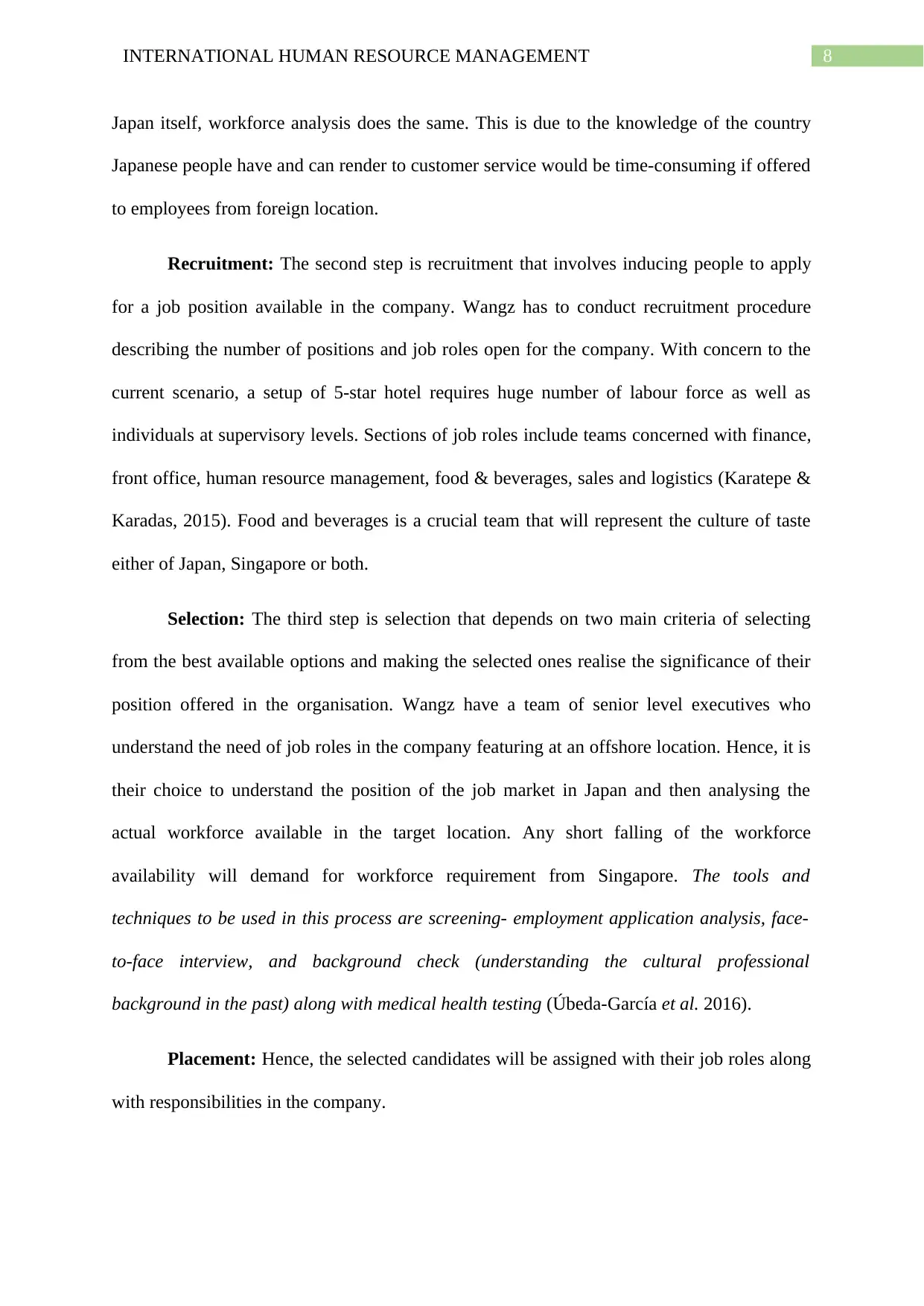
8INTERNATIONAL HUMAN RESOURCE MANAGEMENT
Japan itself, workforce analysis does the same. This is due to the knowledge of the country
Japanese people have and can render to customer service would be time-consuming if offered
to employees from foreign location.
Recruitment: The second step is recruitment that involves inducing people to apply
for a job position available in the company. Wangz has to conduct recruitment procedure
describing the number of positions and job roles open for the company. With concern to the
current scenario, a setup of 5-star hotel requires huge number of labour force as well as
individuals at supervisory levels. Sections of job roles include teams concerned with finance,
front office, human resource management, food & beverages, sales and logistics (Karatepe &
Karadas, 2015). Food and beverages is a crucial team that will represent the culture of taste
either of Japan, Singapore or both.
Selection: The third step is selection that depends on two main criteria of selecting
from the best available options and making the selected ones realise the significance of their
position offered in the organisation. Wangz have a team of senior level executives who
understand the need of job roles in the company featuring at an offshore location. Hence, it is
their choice to understand the position of the job market in Japan and then analysing the
actual workforce available in the target location. Any short falling of the workforce
availability will demand for workforce requirement from Singapore. The tools and
techniques to be used in this process are screening- employment application analysis, face-
to-face interview, and background check (understanding the cultural professional
background in the past) along with medical health testing (Úbeda-García et al. 2016).
Placement: Hence, the selected candidates will be assigned with their job roles along
with responsibilities in the company.
Japan itself, workforce analysis does the same. This is due to the knowledge of the country
Japanese people have and can render to customer service would be time-consuming if offered
to employees from foreign location.
Recruitment: The second step is recruitment that involves inducing people to apply
for a job position available in the company. Wangz has to conduct recruitment procedure
describing the number of positions and job roles open for the company. With concern to the
current scenario, a setup of 5-star hotel requires huge number of labour force as well as
individuals at supervisory levels. Sections of job roles include teams concerned with finance,
front office, human resource management, food & beverages, sales and logistics (Karatepe &
Karadas, 2015). Food and beverages is a crucial team that will represent the culture of taste
either of Japan, Singapore or both.
Selection: The third step is selection that depends on two main criteria of selecting
from the best available options and making the selected ones realise the significance of their
position offered in the organisation. Wangz have a team of senior level executives who
understand the need of job roles in the company featuring at an offshore location. Hence, it is
their choice to understand the position of the job market in Japan and then analysing the
actual workforce available in the target location. Any short falling of the workforce
availability will demand for workforce requirement from Singapore. The tools and
techniques to be used in this process are screening- employment application analysis, face-
to-face interview, and background check (understanding the cultural professional
background in the past) along with medical health testing (Úbeda-García et al. 2016).
Placement: Hence, the selected candidates will be assigned with their job roles along
with responsibilities in the company.
⊘ This is a preview!⊘
Do you want full access?
Subscribe today to unlock all pages.

Trusted by 1+ million students worldwide

9INTERNATIONAL HUMAN RESOURCE MANAGEMENT
Training and development: These are the final stages of staffing that improves the
employee competence level motivating them to understand the job description according to
company policies and structure.
Training and development
Hospitality industry is concerned about making the customers feel acknowledged and
welcome at every need. There are different job roles that has to be fulfilled for satisfying a
customer in this industry. Hosting, representing, specialists, professionals, organisers and
informants are the roles offered in this sector requires a training process to be conducted on
selected candidates for achieving a better performance graph. Behaviour and attitude of
employees in this industry matters the most that evaluate the overall culture of the company
(Ersoy, 2014).
The stages involves in training cycle of Wangz are:
Identifying the need of training: Making employees aware of company policies and
significance of job roles.
Designing the training process: Segmenting sector-wise training can make a transparent and
better understanding of job roles.
Delivering the solution: Communication with trainees.
Applying court environment training: On the job training that refers implication of learned
aspects in the real task.
Evaluation: This is to make the trainees understand the learned materials and results after
implying in the real context.
Training and development: These are the final stages of staffing that improves the
employee competence level motivating them to understand the job description according to
company policies and structure.
Training and development
Hospitality industry is concerned about making the customers feel acknowledged and
welcome at every need. There are different job roles that has to be fulfilled for satisfying a
customer in this industry. Hosting, representing, specialists, professionals, organisers and
informants are the roles offered in this sector requires a training process to be conducted on
selected candidates for achieving a better performance graph. Behaviour and attitude of
employees in this industry matters the most that evaluate the overall culture of the company
(Ersoy, 2014).
The stages involves in training cycle of Wangz are:
Identifying the need of training: Making employees aware of company policies and
significance of job roles.
Designing the training process: Segmenting sector-wise training can make a transparent and
better understanding of job roles.
Delivering the solution: Communication with trainees.
Applying court environment training: On the job training that refers implication of learned
aspects in the real task.
Evaluation: This is to make the trainees understand the learned materials and results after
implying in the real context.
Paraphrase This Document
Need a fresh take? Get an instant paraphrase of this document with our AI Paraphraser
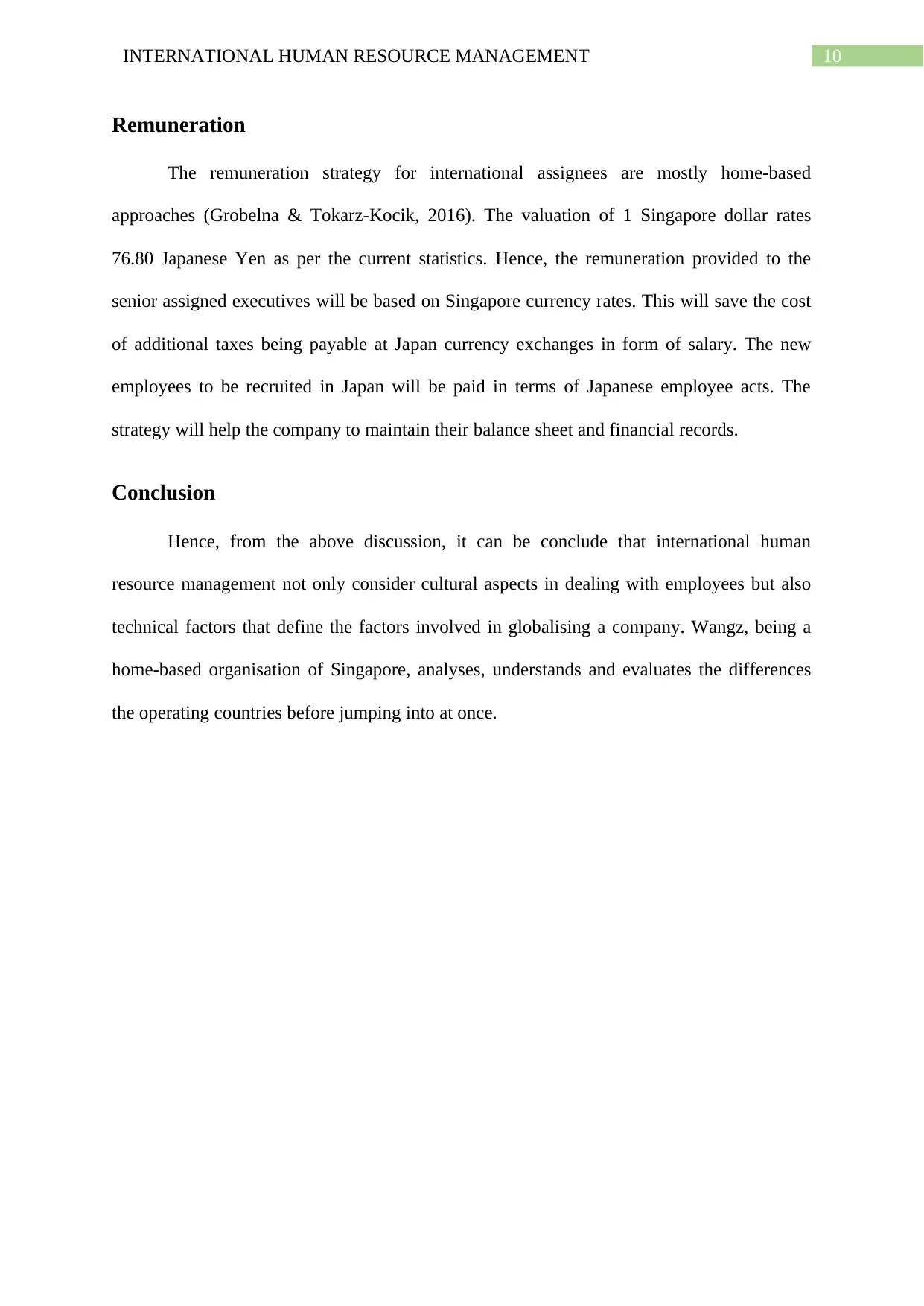
10INTERNATIONAL HUMAN RESOURCE MANAGEMENT
Remuneration
The remuneration strategy for international assignees are mostly home-based
approaches (Grobelna & Tokarz-Kocik, 2016). The valuation of 1 Singapore dollar rates
76.80 Japanese Yen as per the current statistics. Hence, the remuneration provided to the
senior assigned executives will be based on Singapore currency rates. This will save the cost
of additional taxes being payable at Japan currency exchanges in form of salary. The new
employees to be recruited in Japan will be paid in terms of Japanese employee acts. The
strategy will help the company to maintain their balance sheet and financial records.
Conclusion
Hence, from the above discussion, it can be conclude that international human
resource management not only consider cultural aspects in dealing with employees but also
technical factors that define the factors involved in globalising a company. Wangz, being a
home-based organisation of Singapore, analyses, understands and evaluates the differences
the operating countries before jumping into at once.
Remuneration
The remuneration strategy for international assignees are mostly home-based
approaches (Grobelna & Tokarz-Kocik, 2016). The valuation of 1 Singapore dollar rates
76.80 Japanese Yen as per the current statistics. Hence, the remuneration provided to the
senior assigned executives will be based on Singapore currency rates. This will save the cost
of additional taxes being payable at Japan currency exchanges in form of salary. The new
employees to be recruited in Japan will be paid in terms of Japanese employee acts. The
strategy will help the company to maintain their balance sheet and financial records.
Conclusion
Hence, from the above discussion, it can be conclude that international human
resource management not only consider cultural aspects in dealing with employees but also
technical factors that define the factors involved in globalising a company. Wangz, being a
home-based organisation of Singapore, analyses, understands and evaluates the differences
the operating countries before jumping into at once.
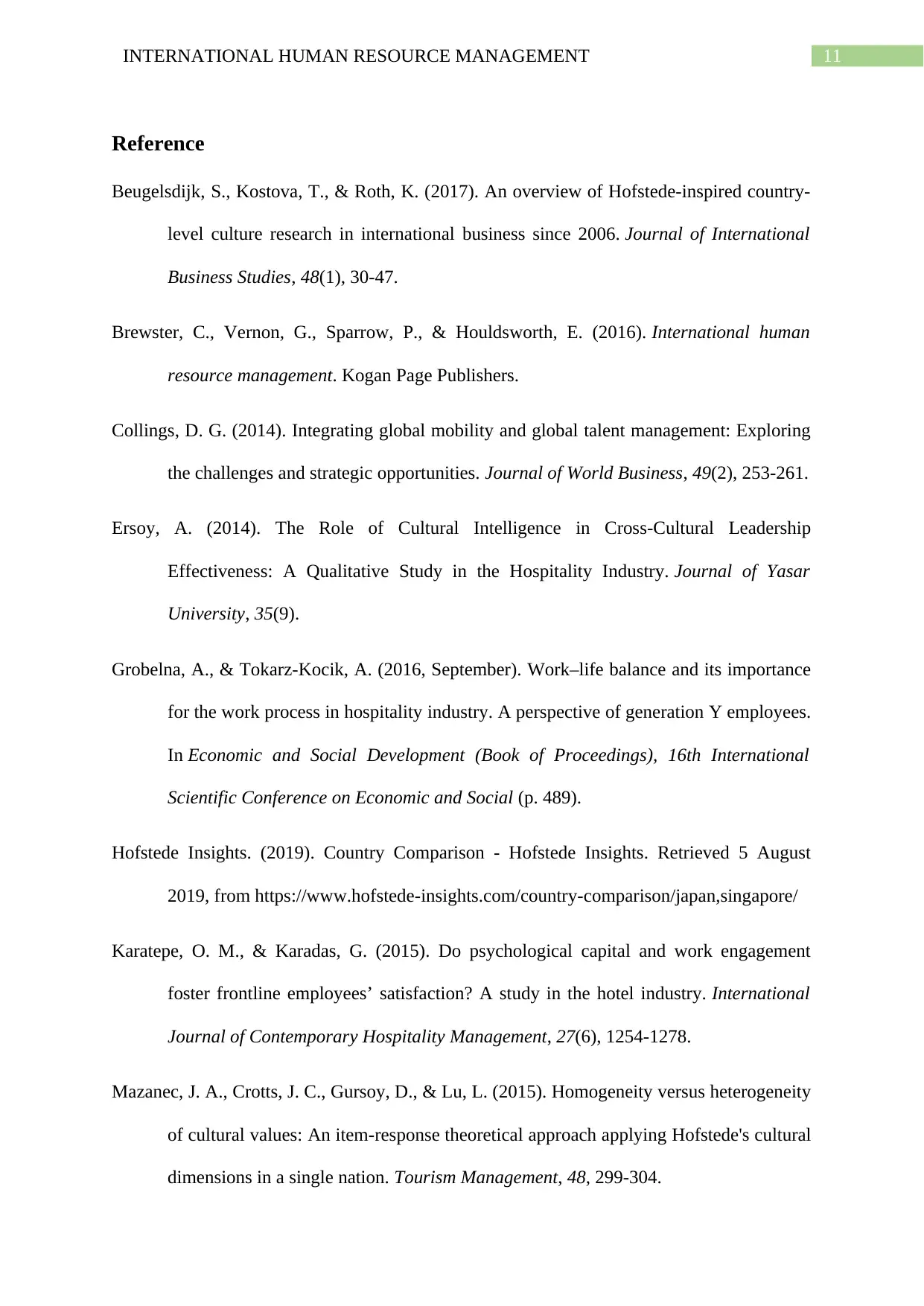
11INTERNATIONAL HUMAN RESOURCE MANAGEMENT
Reference
Beugelsdijk, S., Kostova, T., & Roth, K. (2017). An overview of Hofstede-inspired country-
level culture research in international business since 2006. Journal of International
Business Studies, 48(1), 30-47.
Brewster, C., Vernon, G., Sparrow, P., & Houldsworth, E. (2016). International human
resource management. Kogan Page Publishers.
Collings, D. G. (2014). Integrating global mobility and global talent management: Exploring
the challenges and strategic opportunities. Journal of World Business, 49(2), 253-261.
Ersoy, A. (2014). The Role of Cultural Intelligence in Cross-Cultural Leadership
Effectiveness: A Qualitative Study in the Hospitality Industry. Journal of Yasar
University, 35(9).
Grobelna, A., & Tokarz-Kocik, A. (2016, September). Work–life balance and its importance
for the work process in hospitality industry. A perspective of generation Y employees.
In Economic and Social Development (Book of Proceedings), 16th International
Scientific Conference on Economic and Social (p. 489).
Hofstede Insights. (2019). Country Comparison - Hofstede Insights. Retrieved 5 August
2019, from https://www.hofstede-insights.com/country-comparison/japan,singapore/
Karatepe, O. M., & Karadas, G. (2015). Do psychological capital and work engagement
foster frontline employees’ satisfaction? A study in the hotel industry. International
Journal of Contemporary Hospitality Management, 27(6), 1254-1278.
Mazanec, J. A., Crotts, J. C., Gursoy, D., & Lu, L. (2015). Homogeneity versus heterogeneity
of cultural values: An item-response theoretical approach applying Hofstede's cultural
dimensions in a single nation. Tourism Management, 48, 299-304.
Reference
Beugelsdijk, S., Kostova, T., & Roth, K. (2017). An overview of Hofstede-inspired country-
level culture research in international business since 2006. Journal of International
Business Studies, 48(1), 30-47.
Brewster, C., Vernon, G., Sparrow, P., & Houldsworth, E. (2016). International human
resource management. Kogan Page Publishers.
Collings, D. G. (2014). Integrating global mobility and global talent management: Exploring
the challenges and strategic opportunities. Journal of World Business, 49(2), 253-261.
Ersoy, A. (2014). The Role of Cultural Intelligence in Cross-Cultural Leadership
Effectiveness: A Qualitative Study in the Hospitality Industry. Journal of Yasar
University, 35(9).
Grobelna, A., & Tokarz-Kocik, A. (2016, September). Work–life balance and its importance
for the work process in hospitality industry. A perspective of generation Y employees.
In Economic and Social Development (Book of Proceedings), 16th International
Scientific Conference on Economic and Social (p. 489).
Hofstede Insights. (2019). Country Comparison - Hofstede Insights. Retrieved 5 August
2019, from https://www.hofstede-insights.com/country-comparison/japan,singapore/
Karatepe, O. M., & Karadas, G. (2015). Do psychological capital and work engagement
foster frontline employees’ satisfaction? A study in the hotel industry. International
Journal of Contemporary Hospitality Management, 27(6), 1254-1278.
Mazanec, J. A., Crotts, J. C., Gursoy, D., & Lu, L. (2015). Homogeneity versus heterogeneity
of cultural values: An item-response theoretical approach applying Hofstede's cultural
dimensions in a single nation. Tourism Management, 48, 299-304.
⊘ This is a preview!⊘
Do you want full access?
Subscribe today to unlock all pages.

Trusted by 1+ million students worldwide
1 out of 13
Related Documents
Your All-in-One AI-Powered Toolkit for Academic Success.
+13062052269
info@desklib.com
Available 24*7 on WhatsApp / Email
![[object Object]](/_next/static/media/star-bottom.7253800d.svg)
Unlock your academic potential
Copyright © 2020–2025 A2Z Services. All Rights Reserved. Developed and managed by ZUCOL.





